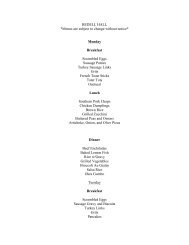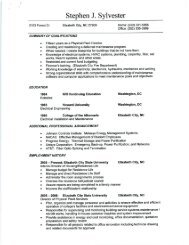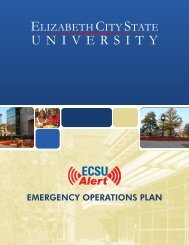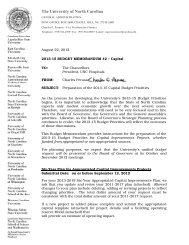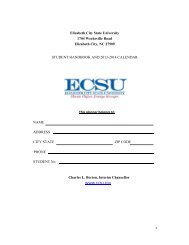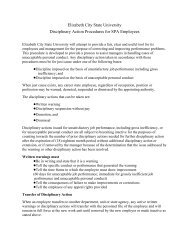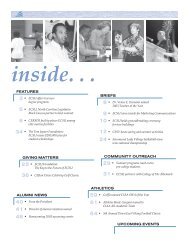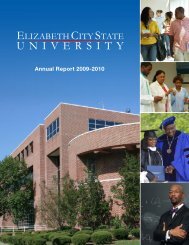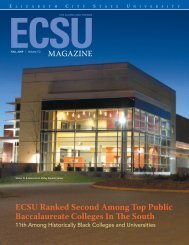Policies & Procedures Manual - Elizabeth City State University
Policies & Procedures Manual - Elizabeth City State University
Policies & Procedures Manual - Elizabeth City State University
Create successful ePaper yourself
Turn your PDF publications into a flip-book with our unique Google optimized e-Paper software.
400.1.48Long-Term ConstructionThe long-term construction costs of buildings are paid with Capital Improvement Funds. Costsare accumulated and expended from the Capitol Improvement Budget while the building is underconstruction. Annually, the project to date expenditures (on the accrual basis) in the CapitolImprovement funds, less items capitalized, are recorded in the Construction in Progress Account.Some of the Construction in Progress costs would include architect fees, plumbing and electricalcontracts, contractor fees, etc. A capitalized cost may include the heating system which cost inexcess of $5,000 and is in place when we begin to move in the building, the long termaccumulated costs are reclassified from Construction in Progress to our Fixed Asset BuildingAccount.<strong>State</strong> AcceptanceAfter a building is inspected by the <strong>State</strong> Construction Office, ECSU will receive a Letter ofAcceptance from the <strong>State</strong> Construction Office. After receipt of the letter and when the buildingis ready for occupancy, the building is considered complete. ECSU should reclassify the amountfrom the Construction in Progress account to the Fixed Asset Building account and issue thebuilding a fixed asset decal number which will be recorded and kept on file in the PurchasingOffice. This should be done whether or not the total Budget Code accounting for the asset hasbeen closed. Upon completion, ECSU should send a Building Update Form to the <strong>State</strong> PropertyOffice, including such information as total costs, square footage, acquisition date, etc. BeginningJuly 1, 1996, ECSU should reconcile its records annually.Separation of CostsSeparate costs of the parts of the building that will probably be replaced before the end of the lifeof the building (such as roofs, plumbing, electrical, etc.) Enter the separate parts as individualassets and assign each separate part and individual decal number. When the "part" needsreplacing, the amount to be written off is then readily available. In most cases, the costs can bebroken down into general construction, heating and air conditioning, electrical and plumbing.The general construction costs will be one asset, with the remaining costs being separate assets.If major renovation takes place on a building, the original cost (less depreciation if applicable) ofthe part of the building being removed is eliminated from the accounts. The cost of removal ofthe renovation should be expensed. The remaining costs of adding the renovation should be aseparate asset.



